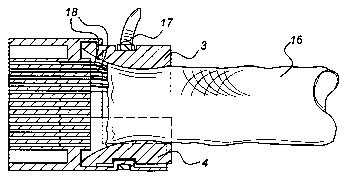Some of the information on this Web page has been provided by external sources. The Government of Canada is not responsible for the accuracy, reliability or currency of the information supplied by external sources. Users wishing to rely upon this information should consult directly with the source of the information. Content provided by external sources is not subject to official languages, privacy and accessibility requirements.
Any discrepancies in the text and image of the Claims and Abstract are due to differing posting times. Text of the Claims and Abstract are posted:
| (12) Patent Application: | (11) CA 2360737 |
|---|---|
| (54) English Title: | ELECTRICAL CONNECTOR |
| (54) French Title: | CONNECTEUR ELECTRIQUE |
| Status: | Deemed Abandoned and Beyond the Period of Reinstatement - Pending Response to Notice of Disregarded Communication |
| (51) International Patent Classification (IPC): |
|
|---|---|
| (72) Inventors : |
|
| (73) Owners : |
|
| (71) Applicants : |
|
| (74) Agent: | SMART & BIGGAR LP |
| (74) Associate agent: | |
| (45) Issued: | |
| (86) PCT Filing Date: | 2000-11-23 |
| (87) Open to Public Inspection: | 2001-05-31 |
| Availability of licence: | N/A |
| Dedicated to the Public: | N/A |
| (25) Language of filing: | English |
| Patent Cooperation Treaty (PCT): | Yes |
|---|---|
| (86) PCT Filing Number: | PCT/NL2000/000857 |
| (87) International Publication Number: | WO 2001039334 |
| (85) National Entry: | 2001-07-23 |
| (30) Application Priority Data: | ||||||
|---|---|---|---|---|---|---|
|
A connector comprises a housing having at least one contact element to which
an electrical conductor can be fixed, as well as a strain relief, connected to
the housing, for transmitting tensile forces between the electrical conductor
and the housing. The strain relief comprises a sleeve which consists of at
least one part, is able to engage on the electrical conductor and is connected
to the housing by means of an interlocking hook connection.
L'invention concerne un connecteur. Ce connecteur comprend un boîtier avec au moins un élément de contact auquel peut être fixé un conducteur électrique, ainsi qu'un réducteur de tension, relié au boîtier pour transmettre les efforts de traction entre le conducteur électrique et le boîtier. Le réducteur de tension comprend un manchon qui se compose au moins d'une partie qui peut se mettre en prise avec le conducteur électrique et est reliée au boîtier au moyen d'un raccordement par crochet .
Note: Claims are shown in the official language in which they were submitted.
Note: Descriptions are shown in the official language in which they were submitted.

2024-08-01:As part of the Next Generation Patents (NGP) transition, the Canadian Patents Database (CPD) now contains a more detailed Event History, which replicates the Event Log of our new back-office solution.
Please note that "Inactive:" events refers to events no longer in use in our new back-office solution.
For a clearer understanding of the status of the application/patent presented on this page, the site Disclaimer , as well as the definitions for Patent , Event History , Maintenance Fee and Payment History should be consulted.
| Description | Date |
|---|---|
| Time Limit for Reversal Expired | 2004-11-23 |
| Application Not Reinstated by Deadline | 2004-11-23 |
| Deemed Abandoned - Failure to Respond to Maintenance Fee Notice | 2003-11-24 |
| Letter Sent | 2002-04-24 |
| Inactive: Single transfer | 2002-03-04 |
| Inactive: Courtesy letter - Evidence | 2001-12-11 |
| Inactive: Cover page published | 2001-12-11 |
| Inactive: Notice - National entry - No RFE | 2001-12-10 |
| Inactive: First IPC assigned | 2001-12-02 |
| Application Received - PCT | 2001-11-15 |
| Application Published (Open to Public Inspection) | 2001-05-31 |
| Abandonment Date | Reason | Reinstatement Date |
|---|---|---|
| 2003-11-24 |
The last payment was received on 2002-10-29
Note : If the full payment has not been received on or before the date indicated, a further fee may be required which may be one of the following
Please refer to the CIPO Patent Fees web page to see all current fee amounts.
| Fee Type | Anniversary Year | Due Date | Paid Date |
|---|---|---|---|
| Basic national fee - standard | 2001-07-23 | ||
| Registration of a document | 2002-03-04 | ||
| MF (application, 2nd anniv.) - standard | 02 | 2002-11-25 | 2002-10-29 |
Note: Records showing the ownership history in alphabetical order.
| Current Owners on Record |
|---|
| FOKKER ELMO B.V. |
| Past Owners on Record |
|---|
| DANIEL DE WAARD |
| FRANCISCUS, HENDRICUS LEENDERTSE |